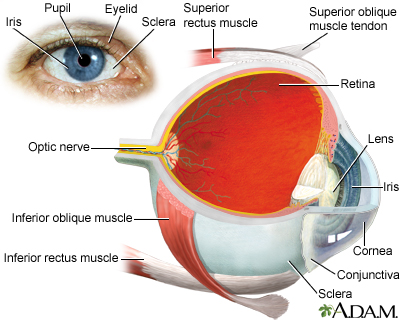Trachoma
Trachoma is an infection of the eye caused by bacteria called chlamydia.
Causes
Trachoma is caused by infection with the bacteria Chlamydia trachomatis.
The condition occurs around the world. It is most often seen in rural areas of developing countries. Children are often affected. However, the scarring caused by the infection may not be noticed until later in life. The condition is rare in the United States. However, it is more likely to occur in crowded or unclean living conditions.
The bacteria that cause trachoma are spread through direct contact with infected eye, nose, or throat fluids. They can also be passed by contact with contaminated objects, such as towels or clothes. Certain flies can also spread the bacteria.
Symptoms
Symptoms begin 5 to 12 days after being exposed to the bacteria. The condition begins slowly. It first appears as inflammation of the tissue lining the eyelids (conjunctivitis, or "pink eye"). Untreated, this may lead to scarring.
Conjunctivitis
The conjunctiva is a clear layer of tissue lining the eyelids and covering the white of the eye. Conjunctivitis occurs when the conjunctiva becomes ...

Symptoms may include:
- Cloudy cornea
Cloudy cornea
A cloudy cornea is a loss of transparency of the cornea.
 ImageRead Article Now Book Mark Article
ImageRead Article Now Book Mark Article - Discharge from the eye
- Swelling of lymph nodes just in front of the ears
- Swollen eyelids
- Turned-in eyelashes
Exams and Tests
The health care provider will do an eye exam to look for scarring on the inside of the upper eye lid, redness of the white part of the eyes, and new blood vessel growth into the cornea.
Lab tests are needed to identify the bacteria and make an accurate diagnosis.
Treatment
Antibiotics can prevent long-term complications if used early in the infection. In certain cases, eyelid surgery may be needed to prevent long-term scarring, which can lead to blindness if not corrected.
Outlook (Prognosis)
Outcomes are very good if treatment is started early before scarring and changes to the eyelids develop.
Possible Complications
If the eyelids become very irritated, the eyelashes may turn in and rub against the cornea. This can cause corneal ulcers, additional scars, vision loss, and possibly, blindness.
When to Contact a Medical Professional
Contact your provider if you or your child recently visited an area where trachoma is common and you notice symptoms of conjunctivitis.
Prevention
Spread of the infection can be limited by washing your hands and face often, keeping clothes clean, and not sharing items such as towels.
Reviewed By
Audrey Tai, DO, MS, Athena Eye Care, Mission Viejo, CA. Also reviewed by David C. Dugdale, MD, Medical Director, Brenda Conaway, Editorial Director, and the A.D.A.M. Editorial team.
Batteiger BE, Tan M. Chlamydia trachomatis (trachoma and urogenital infections). In: Bennett JE, Dolin R, Blaser MJ, eds. Mandell, Douglas, and Bennett's Principles and Practice of Infectious Diseases. 9th ed. Philadelphia, PA: Elsevier; 2020:chap 180.
Hammerschlag MR. Chlamydia trachomatis. In: Kliegman RM, St. Geme JW, Blum NJ, et al, eds. Nelson Textbook of Pediatrics. 22nd ed. Philadelphia, PA: Elsevier; 2025:chap 272.
Rubenstein JB, Kelly E. Infectious conjunctivitis. In: Yanoff M, Duker JS, eds. Ophthalmology. 6th ed. Philadelphia, PA: Elsevier; 2023:chap 4.6.

 All rights reserved.
All rights reserved.